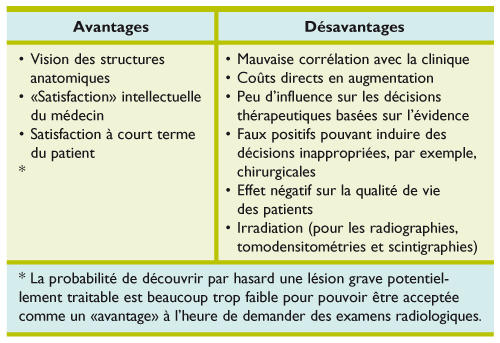MRI (Magnetic Resonance Imaging) is an advanced medical imaging technique that enables doctors to diagnose and treat many conditions. However, despite its many advantages, MRI also has its drawbacks, such as high costs, the time required to perform the examination and the need to remain immobile for an extended period of time. In this article, we take a closer look at advantages and disadvantages of MRI.
MRI: for better or for worse?
MRI, or Magnetic Resonance Imaging, is a medical technology that enables us to visualize the inside of the human body with great precision. Although this technique is very useful for diagnosing certain illnesses and injuries, it can present health risks for patients.
IndeedMRI uses a very powerful magnetic field that can affect electronic medical devices such as pacemakers. In addition, some people may experience anxiety or claustrophobia when inserted into the narrow tunnel of the machine.
NeverthelessMRI is a major advance in the field of medicine, and has led to important discoveries in the treatment of diseases such as cancer and stroke.
In conclusionAlthough MRI presents health risks for patients, and can be a source of discomfort for some, its use is essential for diagnosing and treating certain serious diseases. Ongoing research in this field could also lead to improvements in the technology and methods of use.
Brain MRI essentials for NDA (interpretation principles for all physicians)
[arve url="https://www.youtube.com/embed/oWY58cJqmoI "/]
Basic brain MRI sequences (T1 sequence)
[arve url="https://www.youtube.com/embed/_SsMgFwj4fE "/]
What are the disadvantages of MRI?
MRI (Magnetic Resonance Imaging) is a very useful medical imaging technique for diagnosing various diseases, but it also has certain drawbacks. The main disadvantage of MRI is its high cost. Indeed, the equipment required to perform an MRI is very expensive, making this imaging technique less accessible to some patients.
Another disadvantage of MRI is the length of the examination. Unlike other imaging techniques, such as X-ray or ultrasound, MRI can be very time-consuming. Patients must remain immobile for an extended period (sometimes up to an hour) while the MRI machine takes detailed images of their body.
In addition, MRI may not be suitable for all patients. For example, people with pacemakers or other metallic implants cannot safely undergo MRI. In addition, some people may experience claustrophobia during the examination, as they are placed in a narrow tunnel for an extended period of time.
Finally, MRI results can be difficult to interpret for doctors who are not specifically trained in magnetic resonance imaging. MRI images can be complex and require additional expertise to interpret correctly.
Despite these drawbacks, MRI remains an extremely valuable medical imaging technique for diagnosing and treating a wide range of diseases and conditions.
What are the benefits of MRI?
MRI, or Magnetic Resonance Imaging, is a medical imaging technique that uses a magnetic field and radio waves to visualize the internal organs of the human body. The benefits of MRI are numerous, and can be used in a wide range of medical applications.
Precise diagnosis: MRI is very useful for accurate diagnosis of certain diseases such as brain tumors, spinal cord injuries, heart disease, joint and bone disease, abdominal organ disease, etc.
Patient safety: Unlike X-rays and computed tomography (CT), MRI does not use ionizing radiation that is harmful to the human body. As a result, MRI is considered a very safe imaging method.
Better definition: Thanks to its three-dimensional imaging capability and enhanced contrast, MRI can provide high-quality images to help doctors see the finest details of certain body structures.
Treatment monitoring: MRI can also be used to monitor the progress of certain diseases and patients' response to treatment. For example, it can help assess the effectiveness of chemotherapy in the treatment of certain cancers.
All in all, MRI is a very useful medical imaging method that offers many advantages for accurate diagnosis, patient safety, better definition and treatment monitoring.
Which technique is more accurate than MRI or CT?
MRI is generally considered the most accurate technique for visualizing soft tissues and internal organs, while CT is more precise for images of bone and hard tissue. However, each technique has its own advantages and limitations, depending on the type of imaging required for the patient. Both techniques are non-invasive and provide highly detailed images of the inside of the human body. Doctors often choose between MRI and CT depending on the patient's specific needs and the area of the body to be examined.
What are the reasons for choosing a CT scan over an MRI?
The choice of a CT scan over an MRI depends mainly on three factors:
1. Speed of execution : CT is generally faster than MRI. It can take images in a matter of minutes, while MRI can take 30 to 60 minutes to produce similar images. It's an attractive option for patients who need a rapid diagnosis.
2. Cost : The cost of a CT scan is generally lower than that of an MRI. This can be an important factor for patients who do not have full health insurance, or for hospitals facing budget restrictions.
3. MRI-related contraindications : MRI may not be recommended for patients with metallic foreign bodies or cardiac pacemakers. In such cases, CT is a convenient and safe alternative for obtaining diagnostic images.
In conclusion, although MRI is often considered the most accurate imaging method, CT may be an appropriate choice for many situations due to its speed, cost and lack of MRI-related contraindications.
What are the main advantages of MRI for medical diagnosis?
L'MRI (Magnetic Resonance Imaging) is a non-invasive medical imaging technique that visualizes the internal organs and tissues of the human body using a magnetic field and radio waves. This method has several advantages for medical diagnosis.
First and foremost, MRI provides detailed images of the anatomical structure of organs and tissues, which can help establish an accurate diagnosis and plan appropriate treatment. Unlike radiography or computed tomography (CT), MRI does not produce two-dimensional images, but three-dimensional ones, allowing better visualization of soft tissues and complex structures.
What's more, MRI is safer than other imaging techniques that use ionizing radiation, as it does not emit harmful radiation. This makes it particularly useful for children and pregnant women.
Finally, MRI is able to detect abnormalities that would be difficult or impossible to see with other imaging techniques. For example, it can detect lesions in the brain that would be invisible on an X-ray or CT scan.
In short, MRI is an accurate, safe and non-invasive medical imaging technique that offers numerous advantages for medical diagnosis.
What are the possible drawbacks and risks associated with using MRI?
MRI, or Magnetic Resonance Imaging, is a medical imaging technique used to diagnose certain diseases or abnormalities of the body. Although this technique is considered very safe, it can nevertheless present certain risks and drawbacks.
One of the main disadvantages of MRI is that the patient has to remain immobile for an extended period of time. This can be uncomfortable, especially for patients suffering from claustrophobia. In addition, patients with certain illnesses or injuries may find it difficult to remain still throughout the examination.
Another disadvantage of MRI is its high cost. The equipment needed to perform an MRI is very expensive, which can make the examination inaccessible to some patients.
In terms of potential risks, MRI can be dangerous for people with medical devices such as pacemakers or cochlear implants. These devices may be affected by the magnetic field of MRI, causing malfunction or even irreversible damage.
Finally, in rare cases, allergic reactions may occur following the injection of a contrast agent used in certain MRI examinations. These reactions can range from mild to severe, and often require immediate medical intervention.
Overall, MRI is a very useful and relatively safe medical imaging technique. However, as with any medical treatment, it's important to weigh up the pros and cons before deciding whether to undergo an MRI scan.
How should you prepare for an MRI, and what are the possible side effects?
MRI is a medical imaging technique that provides highly accurate images of the human body. Before undergoing MRI, it's important to prepare properly to minimize any possible side effects.
First of all, we recommend that you wear comfortable, loose-fitting clothing, with no metal parts such as buttons or zippers. MRI uses a powerful magnetic field that can attract metal objects, which can be dangerous for the patient.
Secondly, it is important to inform the radiologist of any medical history or contraindications to the use of MRI, such as the presence of a pacemaker or cochlear implant.
The patient should also avoid consuming any food or drink prior to the examination, as this may affect the quality of the images obtained. In general, it is recommended to fast for 4 hours before the examination.
As far as side effects are concerned, MRI is considered a safe, non-invasive imaging technique. However, some patients may experience a slight feeling of claustrophobia when placed in the narrow tunnel of the machine. In this case, medical staff may administer a sedative to help calm the patient.
In conclusion, although preparation for an MRI requires a few simple restrictions, the examination itself is generally safe and painless. It is important to follow the radiologist's instructions to ensure a successful examination and accurate images.
In conclusion, MRI is an extremely useful medical tool for diagnosing and treating various diseases. However, there are also disadvantages to consider. Although MRI is non-invasive and produces no harmful radiation, the high cost and time required to perform the examination can be limiting factors. In addition, patients suffering from claustrophobia or with metal implants cannot use this technology. Ultimately, each patient must decide whether to use MRI after consulting his or her doctor and weighing up the pros and cons.








